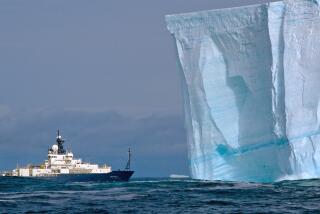Lessons Students Can (Practically) Dive Into : Education: Saddleback science professor Joseph Valencic will be teaching live--sometimes underwater--from Antarctica via satellite.
- Share via
MISSION VIEJO — Diving for sunken treasure in the South Pacific? Been there. Dodging a dozen curious sharks while exploring the ocean’s depths? Done that.
It’s all in a day’s work for marine science professor Joseph Valencic, a pioneer in the field of underwater videography who uses his firsthand experience to introduce students at Saddleback College to the mysteries of the ocean.
The modern-day explorer is preparing to board ship Wednesday for his fifth expedition in 12 years to the Antarctic, where he will brave frigid waters for a close-up look at rare fish, seals, penguins and killer whales.
But this time, he’s bringing his students along. Sort of.
Tapping into the hot new trend of “distance learning,” Valencic will employ the latest computer and video technology to turn one of the Earth’s coldest, iciest and most desolate spots into a two-way interactive classroom.
“This is the future of learning, and we have it here today,” said Valencic, pointing to the computers, monitors, cameras, underwater microphones and other gadgets that allow him to hold class--live--as he walks through a penguin colony or narrates a dive to check out 30-foot jellyfish.
“This captures the thrill of adventure, exploration, what’s happening here and now in the Antarctic,” said Valencic, 52, of Lake Forest. “Not something someone saw two years ago that’s finally making its way into a textbook.”
Live video is routinely used in news-gathering and other fields but is rare in a classroom setting, in part because it is costly. Technology and equipment lent to the school by the Magnavox and Casio corporations will allow Valencic to use a regular telephone to beam images and data to classroom computers and television monitors via satellite.
So, from a considerably warmer climate, more than 150 students will watch Valencic’s every move along with maps, data and videotapes that he sends back to them. And when their professor isn’t 100 feet below the polar icecap, they can even raise their hands and ask questions. A portable monitor will allow Valencic to see and hear his students.
“This way, I know who gets the extra credit for a good question,” joked Valencic, a bearded professor with an infectious enthusiasm for his work.
Anyone with a computer also can keep tabs on Valencic’s trip. The expedition will keep updating an exploration logbook through Saddleback College’s home page on the Internet’s World Wide Web.
Valencic first will fly to Chile, where he will board a cruise ship chartered by naturalists and researchers on a two-week trip that will take them to Deception Island and Paradise Bay along the Antarctic Peninsula.
“It’s the recent advances in communications that make it possible,” said Richard R. Muntz, chairman of UCLA’s computer science department. He monitors computer education trends such as distance learning and expects to see more of it in the future.
The project is seen by environmentalists as a useful way to encourage conservation without compromising fragile environments.
“Any time you can make science real for students and captivate their imagination, it makes the experience more alive and makes them care about it,” said Ruth Shelly, managing director of the Stephen Birch Aquarium-Museum at UC San Diego.
There is much to see in the South Pole, an ecosystem that is struggling with global warming, increasing solar radiation and even human pollution, Valencic said.
But its relative isolation still makes it a perfect science laboratory--especially this time of the year, when humpback whales are mating and penguins’ eggs are hatching. The clear ocean water boasts a visibility of 600 feet and is teeming with an unusual array of fish and wildlife that thrive in the harsh surroundings.
December is considered the height of the Antarctic summer, but the salty ocean water will be 28 degrees Fahrenheit. Valencic will wear 13 layers of undergarments and a drysuit constructed much like an astronaut’s before he can brave the water with high-tech video equipment he designed.
Valencic, who holds the world record for the southernmost dive and a congressional medal for his research, said he hopes to foster a genuine interest in scientific research among his students. Valencic himself learned to love the ocean while scuba-diving off Florida and learning about oceanography.
It’s a love that has led to varied expeditions. He recently returned from Australia’s Great Barrier Reef, where he studied coral life, and is credited with unearthing a Japanese warship that former President George Bush reportedly sank while serving as a Navy pilot during World War II.
That find in the South Pacific helped quell rumors that Ens. Bush had bombed an unarmed vessel: Found among the wreck were antiaircraft devices.
Recently, Valencic was inducted into the Adventurers’ Club, an elite international group that includes Sir Edmund Hillary, the first person to climb Mt. Everest.
“I never get tired of this. It’s the adventure of it, the thought of a new discovery or finding something scientific that no one has discovered before,” Valencic said. “That’s what I hope to pass on to my students. Science isn’t a nerdy, boring thing.”
More to Read
Sign up for Essential California
The most important California stories and recommendations in your inbox every morning.
You may occasionally receive promotional content from the Los Angeles Times.














